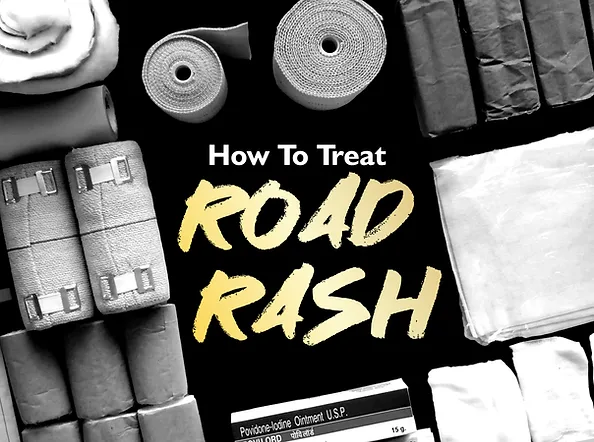Road rash is a common injury that occurs after a motorcycle accident. While we are not doctors and can not fully tell you how to medically heal from this type of injury, we can give you some advice on how to care for it until you can see a doctor. We also have some tips for you to avoid these types of injuries altogether.
What Is Road Rash?
Road rash is an injury that occurs when a person’s skin comes into contact with the road or other abrasive surfaces, typically as the result of a motorcycle accident, bicycle accident, skateboarding accident, etc.
A road rash injury causes friction between the skin and the abrasive surface that causes the outer layers of the skin to scrape away. The severity of these injuries can range from mild to severe, depending on factors such as the speed of impact, the length of time the skin is in contact with the abrasive surface, and the use of protective gear.
Road rash injuries can vary in depth, with superficial road rash affecting only the outermost layers of the skin, while deeper road rash can penetrate through the epidermis into the dermis. The severity of road rash can be classified into three degrees:
First-degree road rash: The outermost layer of the skin (epidermis) is affected, causing superficial abrasions, redness, and minor pain.
Second-degree road rash: The injury extends into the dermis, resulting in deeper abrasions, more intense pain, bleeding, and possible blistering.
Third-degree road rash: The injury extends even deeper into the subcutaneous tissue, causing significant damage to the skin and underlying structures. Third-degree road rash may involve exposed muscle, tendons, or bone.
Regardless of the severity, road rash injury has the potential to become infected due to exposure to dirt, debris, and bacteria from the environment. Therefore, prompt and proper wound care is crucial to minimize the risk of infection and promote healing.
Two Main Types of Road Rash Injuries
Avulsion Injuries
In the context of motorcycle road rash injury, avulsion injuries can occur when the friction between the skin and the road surface forcibly tears away portions of the skin or underlying tissues. Doctors classify road rash as a form of abrasion, but depending on the severity of the accident, it can lead to avulsion injuries as well. Here are a few examples:
Skin avulsions:
This can result in partial or complete skin avulsions, where sections of the skin are torn away from the body. The severity can vary, with mild cases involving superficial loss of skin, while more severe cases may lead to extensive skin loss and exposure of underlying tissues.
Soft tissue avulsions:
This type of injury can cause the tearing or separation of underlying soft tissues, such as muscles, tendons, or ligaments. This can occur when the force of impact or friction causes these tissues to detach or tear away from their normal attachment points.
Partial thickness or full-thickness avulsions:
Depending on the depth and extent of the road rash, it can result in partial or full-thickness avulsion injuries. Partial-thickness avulsions involve the loss of the outer layers of the skin (epidermis and partial dermis), while full-thickness avulsions involve the complete loss of the skin layers down to the subcutaneous tissues or even deeper.
Avulsion injuries, particularly severe ones, can lead to significant pain, bleeding, and potential complications such as infection. It is important to seek immediate medical attention if you or someone else experiences avulsion injuries as a result of road rash or any other traumatic event. A healthcare professional can properly assess the injury, provide appropriate treatment, and minimize the risk of further complications.
Compression Injuries
Compression injuries involve the application of significant force or pressure to a body part, often resulting in damage to underlying tissues or structures.
In a motorcycle accident, compression injuries can arise from various mechanisms, such as the compression of limbs between the motorcycle and another object, compression of the body during a fall or collision, or even the compression of organs due to sudden deceleration forces.
Compression injuries can range from mild to severe and may include:
Crush injuries:
These occur when a body part, such as a limb, is subjected to significant pressure or force, resulting in tissue damage, fractures, or even the destruction of the affected area.
Compartment syndrome:
This occurs when pressure builds up within a closed anatomical compartment, typically due to swelling or bleeding. Compartment syndrome can lead to compromised blood flow, tissue ischemia, and potential nerve and muscle damage.
Internal organ compression:
During a motorcycle accident, the body may experience compression forces that can affect internal organs, potentially leading to injuries such as organ contusions, lacerations, or ruptures.
Vascular injuries:
Compression forces can also cause damage to blood vessels, resulting in bruising, hematoma formation, or even arterial or venous tears.
When compression injuries occur alongside road rash or other traumatic injuries, it is crucial to seek immediate medical attention. Proper evaluation and treatment by healthcare professionals are essential to assess the extent of the injuries, manage any associated complications, and promote optimal recovery.
Complications of Road Rash
Road rash, while often considered a minor injury, can lead to various complications, especially if not properly treated or if the wounds become infected. Some potential complications of road rash include:
Infection:
Road rash exposes the underlying layers of the skin, making it more susceptible to infection. Bacteria from the environment or contaminated objects can enter the wound, leading to an infection.
Scarring:
Depending on the severity of the rash and the depth of the wound, scarring can occur. Deeper wounds or those that heal with complications may result in more noticeable scars. Proper wound care and timely treatment can help minimize the risk of excessive scarring.
Delayed wound healing:
These injuries can take time to heal, especially if they are deep or if the person has underlying health conditions that impair the healing process, such as diabetes or compromised immune function.
Nerve damage:
If the injury is severe, nerves in the affected area can be damaged, leading to altered sensation, numbness, tingling, or even loss of motor function. Nerve damage may require specialized medical attention and rehabilitation to regain function.
It’s important to treat road rash injuries promptly and appropriately to minimize the risk of complications. If you experience road rash or have concerns about your injury, it’s best to consult with a healthcare professional for an accurate assessment and proper treatment guidance.
How to Treat Road Rash from a motorcycle accident
If you have a road rash and are unable to see a doctor immediately, there are some steps you can take at home to provide initial care for the injury. Keep in mind that these recommendations are general in nature, and it’s always best to seek medical attention for a proper evaluation and personalized advice. While these injuries may seem minor, they can become serious without the proper medical treatment. Here’s what you can do:
Clean your hands: Wash your hands thoroughly with soap and water or use an alcohol-based hand sanitizer to minimize the risk of introducing bacteria into the wound.
Stop any bleeding: Apply gentle pressure using a clean cloth or sterile gauze pad to help stop the bleeding. Elevating the affected limb, if possible, can also help reduce blood flow to the wound.
Clean the wound: Gently rinse the road rash wound with clean water or a mild saline solution. Avoid using harsh antiseptics, hydrogen peroxide, or alcohol, as these can damage delicate tissue and slow down the healing process. Use a soft cloth or sterile gauze to clean the area, removing any dirt, debris, or foreign particles. If there are embedded particles, consult a healthcare professional as soon as possible.
Apply an antibiotic ointment: After cleaning the wound, apply a thin layer of over-the-counter antibiotic ointment to help prevent infection. Avoid using creams or ointments that contain neomycin, as some individuals may be allergic to it.
Cover the wound: Protect the road rash with a non-stick sterile dressing or a clean, non-fluffy cloth to prevent further contamination. Use medical tape or a bandage to secure the dressing in place, making sure it’s not too tight to restrict circulation.
Pain management: Over-the-counter pain relievers, such as acetaminophen or ibuprofen, can help manage pain and reduce inflammation.
Monitor for signs of infection: Keep an eye out for signs of infection, such as increasing pain, redness, warmth, swelling, etc.
Remember, these steps are temporary measures until you can see a healthcare professional. It’s important to schedule an appointment as soon as possible for a thorough evaluation and appropriate treatment.
Follow These Tips to Avoid Road Rash From a Motorcycle Accident
To minimize the risk of road rash from a motorcycle accident, it’s essential to prioritize safety and take preventive measures. Here are some tips to help you avoid road rash:
Wear appropriate protective gear: Always wear a well-fitting, full-face helmet approved by safety standards. Additionally, wear protective clothing made of abrasion-resistant materials such as leather or reinforced textile. This includes a jacket, long pants, gloves, and sturdy footwear that covers the ankles.
Use motorcycle-specific protective gear: Consider investing in motorcycle-specific gear designed to protect against road rash. This includes armored jackets and pants, which offer additional impact protection and abrasion resistance.
Choose motorcycles with fairings: Motorcycles with fairings provide added protection by covering the engine and other mechanical components. Fairings can help reduce the risk of direct contact with the road in case of a fall or slide.
Practice defensive riding: Always be alert and anticipate potential hazards on the road. Maintain a safe following distance, avoid aggressive maneuvers, and be mindful of blind spots. Defensive riding can help minimize the likelihood of accidents.
Observe speed limits and ride within your skill level: Excessive speed increases the severity of accidents.
Be mindful of road conditions: Stay vigilant about the road surface and potential hazards such as potholes, loose gravel, or oil spills. Adjust your speed and riding style accordingly to maintain control and minimize the risk of accidents.
Maintain your motorcycle: Regularly inspect and maintain your motorcycle to ensure it is in good working condition. Check tire pressure and tread depth, test brakes, and ensure all lights are functioning properly. Well-maintained motorcycles are less likely to experience mechanical failures that could lead to accidents.
Avoid riding under the influence: Never ride a motorcycle while under the influence of alcohol, drugs, or any substances that impair your judgment, reflexes, and coordination. Impaired riding significantly increases the risk of accidents and road rash.
Remember, road rash can occur even with the best precautions. If you are involved in a motorcycle accident, seek medical attention promptly and follow proper wound care guidelines to reduce the severity and complications of road rash. You also may want to contact an experienced motorcycle accident attorney to go over your case and legal options with you.
Did You Suffer Road Rash in a Motorcycle Accident?
Experiencing road rash as a result of a motorcycle accident can be a distressing and painful ordeal. If you have suffered road rash, it is crucial to prioritize your health and well-being. Seeking immediate medical attention is vital to assess the extent of your injuries and receive appropriate treatment. Additionally, it’s advisable to consider consulting a personal injury attorney to understand your legal rights and options.
Call Demesmin and Dover law firm today who represent numerous individuals who have been injured in accidents. Their attorneys have expertise in navigating the legal complexities surrounding personal injury cases, including those involving motorcycle accidents and road rash injuries. So call the motorcycle accident attorneys at Demesmin and Dover Law Firm today at 866-954-MORE (6673).



